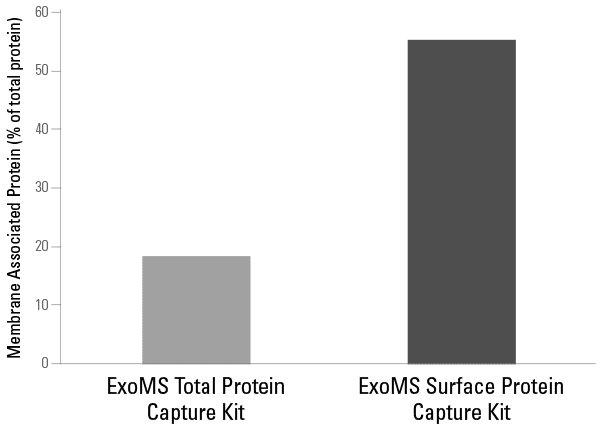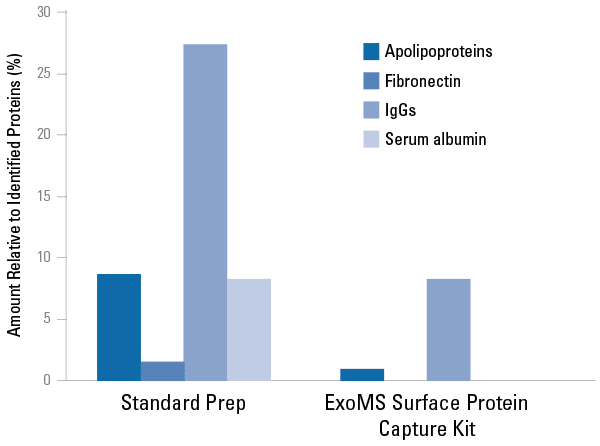ExoMS™ Surface Protein Capture Kit (Serum/Plasma)
Products
| Catalog Number | Description | Size | Price | Quantity | Add to Cart | |||
|---|---|---|---|---|---|---|---|---|
| EXOMS100A-4 | ExoMS™ Surface Protein Capture Kit (Serum/Plasma) | 4 Reactions | $529 |
|
||||
| EXOMS101A-8 | ExoMS™ Surface Protein Capture Kit (Serum/Plasma) | 8 Reactions | $969 |
|
||||
Overview
Overview
Eavesdrop on the EV “surfeome”
Take advantage of powerful LC/MS proteomics approaches to study the biology of surface-associated extracellular vesicle (EV) proteins (the surfeome) and to identify EV surface biomarkers using SBI’s ExoMSTM Surface Protein Capture Kit (Serum/Plasma). The kit provides a fast, well-validated, and robust method for selectively capturing surface and membrane-associated proteins from EVs that have already been isolated from serum or plasma, enabling proteomics studies of this important subset of EV proteins. Because of the low residual protein carryover delivered by this kit, you get increased detection of low-abundance biomarkers that are often missed using traditional approaches.
Ensure that your exosomes are telling you everything with SBI’s ExoMSTM Surface Protein Capture Kit (Serum/Plasma).
- Unique—the only commercially available kit that specifically captures exosome surface and membrane proteins
- Sensitive—removes many common contaminants from EV preps, such as albumin and IgG, for improved biomarker detection by LC/MS
- Compatible—works with EVs isolated using a variety of methods including ExoQuick®, ExoQuick® PLUS, ultracentrifugation, and most column-based kits sold by other vendors
- Fast—go from isolated sample to LC/MS in less than 5 hours
- Flexible—choose this kit for exosomes isolated from serum or plasma, the ExoMS Surface Protein Capture Kit (Tissue Culture) for exosomes isolated from tissue culture or other biofluids, or the ExoMS Total Protein Capture Kit to isolate all EV proteins from exosomes isolated from any biofluid
References
How It Works
How It Works
Delivering sensitive protein detection through reduced protein carryover
Our robust surface and membrane protein capture technology is based on a two-step biotinylation and bead capture method that efficiently sequesters surface and membrane proteins away from internal EV proteins. The result is a protein preparation significantly enriched in membrane-associated proteins (Figure 1).
Figure 1. Membrane-associated proteins are enriched in human serum EV samples processed with the ExoMS Surface Protein Capture Kit compared to samples processed with the ExoMS Total Protein Capture Kit.
In addition, the ExoMS Surface Protein Capture Kit is able to deliver sensitive biomarker detection through the use of a proprietary, affinity-based resin that traps many of the carryover-proteins commonly co-isolated with EVs, but which are not actually carried in or on the surface of EVs (Figure 2). Reduction of these protein contaminants, such as albumin and IgG, reduces their strong signal during mass spec analysis, enabling improved detection of more relevant but lower-abundance proteins.
Figure 2. Common carryover proteins are reduced in human serum EV samples processed with the ExoMS Kit compared to samples processed using a standard protocol.
Supporting Data
Supporting Data
Proteins identified from an ExoMS Surface Protein Capture Kit-prepared sample
See the 25 most abundant membrane-associated proteins identified by LC/MS from a human serum EV sample prepared with the ExoMS Surface Protein Capture Kit. Highlighted entries are proteins which were identified from a sample prepared using the ExoMS Surface Protein Capture Kit and not detected in comparable MS analysis of total EV protein from isolated exosomes, demonstrating the enhanced sensitivity and capability provided by the ExoMS kit for detecting surface and membrane-associated EV proteins.
| Top 25 identified hits for ExoMS Surface Kit | Accession Number | MW | MW ExoMS |
|---|---|---|---|
| Alpha-2-macroglobulin OS=Homo sapiens GN=A2M PE=1 SV=3 | sp|P01023|A2MG_HUMAN | 163 kDa | 846 |
| Haptoglobin OS=Homo sapiens GN=HP PE=1 SV=1 | sp|P00738|HPT_HUMAN | 45 kDa | 190 |
| Desmoplakin OS=Homo sapiens GN=DSP PE=1 SV=3 | sp|P15924|DESP_HUMAN | 332 kDa | 170 |
| Pregnancy zone protein OS=Homo sapiens GN=PZP PE=1 SV=4 | sp|P20742|PZP_HUMAN | 164 kDa | 165 |
| Ceruloplasmin OS=Homo sapiens GN=CP PE=1 SV=1 | sp|P00450|CERU_HUMAN | 122 kDa | 149 |
| Serpin B3 OS=Homo sapiens GN=SERPINB3 PE=1 SV=2 | sp|P29508|SPB3_HUMAN | 45 kDa | 111 |
| Serpin B4 OS=Homo sapiens GN=SERPINB4 PE=1 SV=2 | sp|P48594|SPB4_HUMAN | 45 kDa | 104 |
| Haptoglobin-related protein OS=Homo sapiens GN=HPR PE=2 SV=2 | sp|P00739|HPTR_HUMAN | 39 kDa | 101 |
| Actin, cytoplasmic 2 OS=Homo sapiens GN=ACTG1 PE=1 SV=1 | sp|P63261|ACTG_HUMAN | 42 kDa | 75 |
| Hemopexin OS=Homo sapiens GN=HPX PE=1 SV=2 | sp|P02790|HEMO_HUMAN | 52 kDa | 72 |
| 14-3-3 protein sigma OS=Homo sapiens GN=SFN PE=1 SV=1 | sp|P31947|1433S_HUMAN | 28 kDa | 65 |
| Complement C4-B OS=Homo sapiens GN=C4B PE=1 SV=2 | sp|P0C0L5|CO4B_HUMAN | 193 kDa | 63 |
| Apolipoprotein B-100 OS=Homo sapiens GN=APOB PE=1 SV=2 | sp|P04114|APOB_HUMAN | 516 kDa | 55 |
| Alpha-2-HS-glycoprotein OS=Homo sapiens GN=AHSG PE=1 SV=1 | sp|P02765|FETUA_HUMAN | 39 kDa | 50 |
| Protein S100-A9 OS=Homo sapiens GN=S100A9 PE=1 SV=1 | sp|P06702|S10A9_HUMAN | 13 kDa | 46 |
| Epiplakin OS=Homo sapiens GN=EPPK1 PE=1 SV=2 | sp|P58107|EPIPL_HUMAN | 556 kDa | 45 |
| Vitamin D-binding protein OS=Homo sapiens GN=GC PE=1 SV=1 | sp|P02774|VTDB_HUMAN | 53 kDa | 44 |
| Annexin A2 OS=Homo sapiens GN=ANXA2 PE=1 SV=2 | sp|P07355|ANXA2_HUMAN | 39 kDa | 43 |
| Galectin-7 OS=Homo sapiens GN=LGALS7 PE=1 SV=2 | sp|P47929|LEG7_HUMAN | 15 kDa | 42 |
| Glyceraldehyde-3-phosphate dehydrogenase OS=Homo sapiens GN=GAPDH PE=1 SV=3 | sp|P04406|G3P_HUMAN | 36 kDa | 39 |
| Junction plakoglobin OS=Homo sapiens GN=JUP PE=1 SV=3 | sp|P14923|PLAK_HUMAN | 82 kDa | 38 |
| Fatty acid-binding protein, epidermal OS=Homo sapiens GN=FABP5 PE=1 SV=3 | sp|Q01469|FABP5_HUMAN | 15 kDa | 37 |
| Pyruvate kinase PKM OS=Homo sapiens GN=PKM PE=1 SV=4 | sp|P14618|KPYM_HUMAN | 58 kDa | 37 |
| Alpha-enolase OS=Homo sapiens GN=ENO1 PE=1 SV=2 | sp|P06733|ENOA_HUMAN | 47 kDa | 36 |
| Denotes surface or membrane-associated protein identified using the ExoMS Surface Protein Capture kit but not detected in comparable MS analysis of total EV protein from isolated exosomes | |||
FAQs
Documentation
Citations
Related Products
Products
| Catalog Number | Description | Size | Price | Quantity | Add to Cart | |||
|---|---|---|---|---|---|---|---|---|
| EXOMS100A-4 | ExoMS™ Surface Protein Capture Kit (Serum/Plasma) | 4 Reactions | $529 |
|
||||
| EXOMS101A-8 | ExoMS™ Surface Protein Capture Kit (Serum/Plasma) | 8 Reactions | $969 |
|
||||
Overview
Overview
Eavesdrop on the EV “surfeome”
Take advantage of powerful LC/MS proteomics approaches to study the biology of surface-associated extracellular vesicle (EV) proteins (the surfeome) and to identify EV surface biomarkers using SBI’s ExoMSTM Surface Protein Capture Kit (Serum/Plasma). The kit provides a fast, well-validated, and robust method for selectively capturing surface and membrane-associated proteins from EVs that have already been isolated from serum or plasma, enabling proteomics studies of this important subset of EV proteins. Because of the low residual protein carryover delivered by this kit, you get increased detection of low-abundance biomarkers that are often missed using traditional approaches.
Ensure that your exosomes are telling you everything with SBI’s ExoMSTM Surface Protein Capture Kit (Serum/Plasma).
- Unique—the only commercially available kit that specifically captures exosome surface and membrane proteins
- Sensitive—removes many common contaminants from EV preps, such as albumin and IgG, for improved biomarker detection by LC/MS
- Compatible—works with EVs isolated using a variety of methods including ExoQuick®, ExoQuick® PLUS, ultracentrifugation, and most column-based kits sold by other vendors
- Fast—go from isolated sample to LC/MS in less than 5 hours
- Flexible—choose this kit for exosomes isolated from serum or plasma, the ExoMS Surface Protein Capture Kit (Tissue Culture) for exosomes isolated from tissue culture or other biofluids, or the ExoMS Total Protein Capture Kit to isolate all EV proteins from exosomes isolated from any biofluid
References
How It Works
How It Works
Delivering sensitive protein detection through reduced protein carryover
Our robust surface and membrane protein capture technology is based on a two-step biotinylation and bead capture method that efficiently sequesters surface and membrane proteins away from internal EV proteins. The result is a protein preparation significantly enriched in membrane-associated proteins (Figure 1).
Figure 1. Membrane-associated proteins are enriched in human serum EV samples processed with the ExoMS Surface Protein Capture Kit compared to samples processed with the ExoMS Total Protein Capture Kit.
In addition, the ExoMS Surface Protein Capture Kit is able to deliver sensitive biomarker detection through the use of a proprietary, affinity-based resin that traps many of the carryover-proteins commonly co-isolated with EVs, but which are not actually carried in or on the surface of EVs (Figure 2). Reduction of these protein contaminants, such as albumin and IgG, reduces their strong signal during mass spec analysis, enabling improved detection of more relevant but lower-abundance proteins.
Figure 2. Common carryover proteins are reduced in human serum EV samples processed with the ExoMS Kit compared to samples processed using a standard protocol.
Supporting Data
Supporting Data
Proteins identified from an ExoMS Surface Protein Capture Kit-prepared sample
See the 25 most abundant membrane-associated proteins identified by LC/MS from a human serum EV sample prepared with the ExoMS Surface Protein Capture Kit. Highlighted entries are proteins which were identified from a sample prepared using the ExoMS Surface Protein Capture Kit and not detected in comparable MS analysis of total EV protein from isolated exosomes, demonstrating the enhanced sensitivity and capability provided by the ExoMS kit for detecting surface and membrane-associated EV proteins.
| Top 25 identified hits for ExoMS Surface Kit | Accession Number | MW | MW ExoMS |
|---|---|---|---|
| Alpha-2-macroglobulin OS=Homo sapiens GN=A2M PE=1 SV=3 | sp|P01023|A2MG_HUMAN | 163 kDa | 846 |
| Haptoglobin OS=Homo sapiens GN=HP PE=1 SV=1 | sp|P00738|HPT_HUMAN | 45 kDa | 190 |
| Desmoplakin OS=Homo sapiens GN=DSP PE=1 SV=3 | sp|P15924|DESP_HUMAN | 332 kDa | 170 |
| Pregnancy zone protein OS=Homo sapiens GN=PZP PE=1 SV=4 | sp|P20742|PZP_HUMAN | 164 kDa | 165 |
| Ceruloplasmin OS=Homo sapiens GN=CP PE=1 SV=1 | sp|P00450|CERU_HUMAN | 122 kDa | 149 |
| Serpin B3 OS=Homo sapiens GN=SERPINB3 PE=1 SV=2 | sp|P29508|SPB3_HUMAN | 45 kDa | 111 |
| Serpin B4 OS=Homo sapiens GN=SERPINB4 PE=1 SV=2 | sp|P48594|SPB4_HUMAN | 45 kDa | 104 |
| Haptoglobin-related protein OS=Homo sapiens GN=HPR PE=2 SV=2 | sp|P00739|HPTR_HUMAN | 39 kDa | 101 |
| Actin, cytoplasmic 2 OS=Homo sapiens GN=ACTG1 PE=1 SV=1 | sp|P63261|ACTG_HUMAN | 42 kDa | 75 |
| Hemopexin OS=Homo sapiens GN=HPX PE=1 SV=2 | sp|P02790|HEMO_HUMAN | 52 kDa | 72 |
| 14-3-3 protein sigma OS=Homo sapiens GN=SFN PE=1 SV=1 | sp|P31947|1433S_HUMAN | 28 kDa | 65 |
| Complement C4-B OS=Homo sapiens GN=C4B PE=1 SV=2 | sp|P0C0L5|CO4B_HUMAN | 193 kDa | 63 |
| Apolipoprotein B-100 OS=Homo sapiens GN=APOB PE=1 SV=2 | sp|P04114|APOB_HUMAN | 516 kDa | 55 |
| Alpha-2-HS-glycoprotein OS=Homo sapiens GN=AHSG PE=1 SV=1 | sp|P02765|FETUA_HUMAN | 39 kDa | 50 |
| Protein S100-A9 OS=Homo sapiens GN=S100A9 PE=1 SV=1 | sp|P06702|S10A9_HUMAN | 13 kDa | 46 |
| Epiplakin OS=Homo sapiens GN=EPPK1 PE=1 SV=2 | sp|P58107|EPIPL_HUMAN | 556 kDa | 45 |
| Vitamin D-binding protein OS=Homo sapiens GN=GC PE=1 SV=1 | sp|P02774|VTDB_HUMAN | 53 kDa | 44 |
| Annexin A2 OS=Homo sapiens GN=ANXA2 PE=1 SV=2 | sp|P07355|ANXA2_HUMAN | 39 kDa | 43 |
| Galectin-7 OS=Homo sapiens GN=LGALS7 PE=1 SV=2 | sp|P47929|LEG7_HUMAN | 15 kDa | 42 |
| Glyceraldehyde-3-phosphate dehydrogenase OS=Homo sapiens GN=GAPDH PE=1 SV=3 | sp|P04406|G3P_HUMAN | 36 kDa | 39 |
| Junction plakoglobin OS=Homo sapiens GN=JUP PE=1 SV=3 | sp|P14923|PLAK_HUMAN | 82 kDa | 38 |
| Fatty acid-binding protein, epidermal OS=Homo sapiens GN=FABP5 PE=1 SV=3 | sp|Q01469|FABP5_HUMAN | 15 kDa | 37 |
| Pyruvate kinase PKM OS=Homo sapiens GN=PKM PE=1 SV=4 | sp|P14618|KPYM_HUMAN | 58 kDa | 37 |
| Alpha-enolase OS=Homo sapiens GN=ENO1 PE=1 SV=2 | sp|P06733|ENOA_HUMAN | 47 kDa | 36 |
| Denotes surface or membrane-associated protein identified using the ExoMS Surface Protein Capture kit but not detected in comparable MS analysis of total EV protein from isolated exosomes | |||

